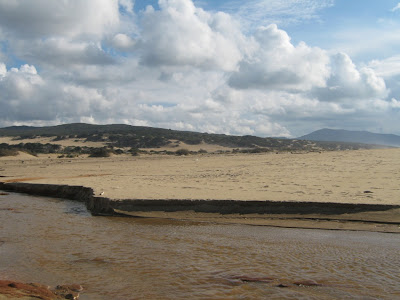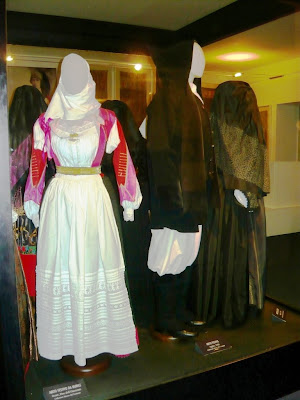
April 1st : Wednesday
Breakfast in the family. At 8.30 am– cultural naturalistic trip: departure by bus to Buggerru and Ingurtosu (west coast). At 13.30 lunch in Montevecchio: In the afternoon visit to the dunes of Piscinas and the seashore with the leaders of Legambiente. (our reference point for zonal environmental education and cultural beauties of nature - Costa Verde, Scivu, dunes and beaches of Piscinas, Montevecchio)
At 20.30 return to host families and dinner. Participants: the class of Bucharest + class I D of our Institute + 5 students of III D.
San Gavino Monreale 02/04/09 Simone I D
TRIP TO COSTA VERDE
Yesterday April 1st we went on a trip, along with school friends from Romania, to visit the “Costa Verde”. We left at least nine quarter, and we went to Buggerru. During the long journey many of us felt badly for the many turns of the route. Once in Montevecchio, we stopped at the home of Legambiente, to book our lunch. Then the bus went to Buggerru. We visited the port and the beach, where we then made a small break, along with Romanian school friends. At noon we set out again towards Montevecchio to go to eat at the home of Legambiente. We ate pasta with sauce and a slice "Alla Milanese" with French fries. We were all a little tired for the long journey, but when we arrived at the Dune Piscinas and as if we had reloaded, and we got to play everywhere. I was astonished because I had never gone to see them and can assure you that I am really huge!. Then the teacher saw that we were away, and then told us to put in place to control us better but but he did not know that our friend had lost a shoe in the kind of sand and found lots of rust and then he had to go home completely bare foot. Then we returned back to San Gavino.
San Gavino Monreale 02/04/09
VOYAGE AU COSTA VERDE
Hier, 1er avril, nous sommes allés en voyage, avec les amis de Roumanie, pour visiter la côte en vert (Costa Verde). Nous sommes partis à neuf heures moins quart, et nous avons été dirigés vers Buggerru. Durant le long voyage beaucoup d'entre nous se sont sentis mal pour les nombreux virages de la route. Une fois dans Montevecchio, nous nous sommes arrêtés au domicile de Legambiente, à réserver notre déjeuner. Ensuite, nous avons été dirigés vers Buggerru. Arrivé làbas nous sommes allés visiter le port et la plage, où nous avons ensuite fait un petit break, avec nos amis roumains. A midi, nous sommes allès vers Montevecchio pour aller manger à la maison de Legambiente, où nous avons mangé de la pasta avec une sauce et une tranche à la “Milanese” avec des frites. Nous avons tous été un peu fatigué pour le long voyage que nous avons fait deux fois de suite, mais quand nous sommes arrivés à la Dune Piscinas et comme si on avait rechargé, et nous avons jouè partout. J'ai été étonné parce que je n'avais jamais allé les voir et puis je vous assure que les Dunes Piscinas sont vraiment énormes!. Ensuite, l'enseignant a vu que nous étions loin, et puis il nous a dit de nons mettre en place pour mieux nous contrôler, mais il ne savait que notre copain avait perdu une chaussure dans le genre de sable et a trouvé plein de rouille, puis il fallait rentrer à la maison complètement nus-pieds. Ensuite, tous les enseignants, nous avons attiré là, parce que nous devions retournés à San Gavino.
San Gavino Monreale 02/04/09
GITA ALLA COSTA VERDE
Ieri primo Aprile siamo andati in gita,insieme ai ragazzi rumeni,a visitare la costa verde. Siamo partiti alle nove meno un quarto e ci siamo diretti verso Buggerru. Durante il lungo tragitto molti di noi si sono sentiti male per le troppe curve del tragitto. Arrivati a Montevecchio, ci siamo fermati alla sede della Legambiente, per prenotare il pranzo lì. Poi il pullman è ripartito e ci siamo diretti verso Buggerru. Arrivati siamo andati a visitare il porto e la spiaggia, dove poi abbiamo fatto una piccola sosta, insieme ai ragazzi rumeni. A mezzogiorno ci siamo incamminati di nuovo verso Montevecchio per andare a mangiare alla sede della Legambiente, dove abbiamo mangiato la pasta al sugo e una fettina impanata con patatine fritte. Eravamo tutti un po’ stanchi per il lunghissimo viaggio che ci siamo fatti per ben due volte di fila, ma quando siamo arrivati alle Dune di Piscinas e come se ci fossimo ricaricati, e ci siamo messi a giocare dappertutto. Io sono rimasto sbalordito perché non ero mai andato a vederle e posso assicurare che sono davvero enormi!. Poi il professore ha visto che ci stavamo allontanando,e allora ci ha detto di metterci in posto dove poteva controllarci meglio ma noi gli avevamo detto che non potevamo perché un nostro compagno aveva perso la scarpa in delle specie di sabbie mobili e le ha ritrovate piene zeppe di ruggine, allora è dovuto tornare a casa completamente scalzo. Poi tutti i professori ci hanno richiamato perché ce ne dovevamo andare, così abbiamo preso il pullman e siamo tornati a San Gavino.
An Excursions Another student - Class I D
Yesterday, April 1st, we went on excursions with the school. There were also our Romanians friends with us and we showed them some places of our island.
At 8.30 we were all in the school yard. After the call, we got on the bus and we went to Guspini.
Once in Guspini the bus had a breakdown and we stopped for a quarter of an hour, waiting for the mechanics to repair the brakes. After that we resumed our journey towards Arbus.
Once in Arbus, I and many of my schoolfriends, we weren't very well. In fact, every five minutes the bus stopped and we took a breath of air.
Once in Buggerru we stayed in port and from there we went to the beach. We held for about half an hour and then we returned to Montevecchio for lunch. After finishing lunch we went to visit "Le Dune" by Piscinas and then we returned to San Gavino.
Hier, le 1er avril, nous sommes allés faire une excursions avec l'école. Nos amis Roumains etaient avec nous, et nous les avons montré certains endroits de notre île.
À 8,30, nous étions tous dans la cour de l'école. Après l'appel, nous avons eu dans le bus et nous ont été adressées à Guspini.
Une fois dans le bus nous nous sommes arretés à Guspini. Le bus avait une panne et nous avons été arrêtés pendant un quart d'heure d'attente pour les mécaniciens pour réparer les freins. Après nous avons repris notre chemin vers l'Arbus.
Une fois à Arbus, moi et beaucoup de mes camarades, nous avions mal au stomac. Nous demandions l'arrêt de bus toutes les cinq minutes pour prendre une bouffée d'air.
Une fois que nous nous sommes arrêtés dans Buggerru au port et à partir de là, nous sommes allés à la plage. Nous avons tenu pendant environ une demi-heure, puis nous sommes retournés à Montevecchio pour le déjeuner. Après avoir terminé le déjeuner nous sommes allés visiter "Le Dune" par Piscinas, puis nous sommes retournés à San Gavino.
Gita
Ieri 1 Aprile siamo andati in gita con la scuola. Con noi c'erano anche i ragazzi Rumeni e abbiamo mostrato loro alcuni luoghi della nostra isola.
Alle 8,30 eravamo tutti nel piazzale della scuola. Dopo aver fatto l'appello, siamo saliti sul pullman e ci siamo diretti verso Guspini.
Arrivati a Guspini, il pullman ha avuto un guasto e siamo rimasti fermi per un quarto d'ora, aspettando i meccanici per riparare i freni. Dopo abbiamo ripreso il nostro cammino verso Arbus.
Una volta arrivati ad Arbus, io e molti dei miei compagni siamo stati male. Il pullman si fermava ogni cinque minuti per far prendere una boccata d'aria.
Arrivati a Buggerru abbiamo sostato al porticciolo e da lì siamo andati in spiaggia. Ci siamo trattenuti per circa mezz'ora e poi siamo rientrati a Montevecchio per il pranzo. Dopo aver terminato il pranzo ci siamo recati a vistare “Le Dune” di Piscinas e infine abbiamo fatto rientro a San Gavino.
Lunch in Montevecchio - Legambiente

































 and the Carnival's masks of Barbagia are on display
and the Carnival's masks of Barbagia are on display


























